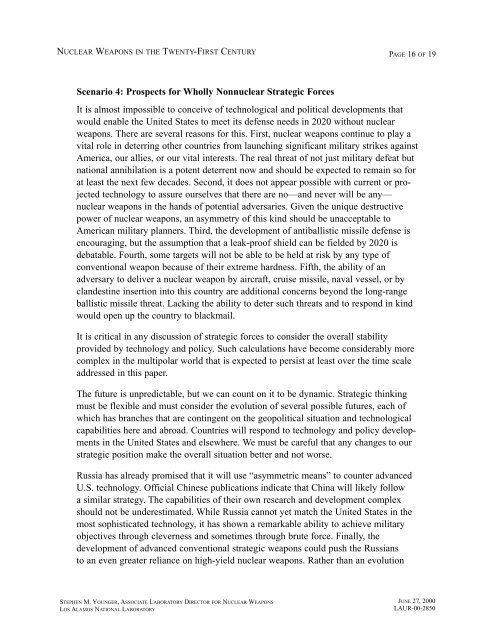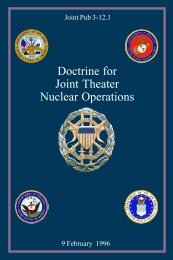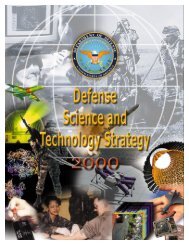Nuclear Weapons in the Twenty-First Century - Sciencemadness.org
Nuclear Weapons in the Twenty-First Century - Sciencemadness.org
Nuclear Weapons in the Twenty-First Century - Sciencemadness.org
Create successful ePaper yourself
Turn your PDF publications into a flip-book with our unique Google optimized e-Paper software.
NUCLEAR WEAPONS IN THE TWENTY-FIRST CENTURY<br />
PAGE 16 OF 19<br />
Scenario 4: Prospects for Wholly Nonnuclear Strategic Forces<br />
It is almost impossible to conceive of technological and political developments that<br />
would enable <strong>the</strong> United States to meet its defense needs <strong>in</strong> 2020 without nuclear<br />
weapons. There are several reasons for this. <strong>First</strong>, nuclear weapons cont<strong>in</strong>ue to play a<br />
vital role <strong>in</strong> deterr<strong>in</strong>g o<strong>the</strong>r countries from launch<strong>in</strong>g significant military strikes aga<strong>in</strong>st<br />
America, our allies, or our vital <strong>in</strong>terests. The real threat of not just military defeat but<br />
national annihilation is a potent deterrent now and should be expected to rema<strong>in</strong> so for<br />
at least <strong>the</strong> next few decades. Second, it does not appear possible with current or projected<br />
technology to assure ourselves that <strong>the</strong>re are no—and never will be any—<br />
nuclear weapons <strong>in</strong> <strong>the</strong> hands of potential adversaries. Given <strong>the</strong> unique destructive<br />
power of nuclear weapons, an asymmetry of this k<strong>in</strong>d should be unacceptable to<br />
American military planners. Third, <strong>the</strong> development of antiballistic missile defense is<br />
encourag<strong>in</strong>g, but <strong>the</strong> assumption that a leak-proof shield can be fielded by 2020 is<br />
debatable. Fourth, some targets will not be able to be held at risk by any type of<br />
conventional weapon because of <strong>the</strong>ir extreme hardness. Fifth, <strong>the</strong> ability of an<br />
adversary to deliver a nuclear weapon by aircraft, cruise missile, naval vessel, or by<br />
clandest<strong>in</strong>e <strong>in</strong>sertion <strong>in</strong>to this country are additional concerns beyond <strong>the</strong> long-range<br />
ballistic missile threat. Lack<strong>in</strong>g <strong>the</strong> ability to deter such threats and to respond <strong>in</strong> k<strong>in</strong>d<br />
would open up <strong>the</strong> country to blackmail.<br />
It is critical <strong>in</strong> any discussion of strategic forces to consider <strong>the</strong> overall stability<br />
provided by technology and policy. Such calculations have become considerably more<br />
complex <strong>in</strong> <strong>the</strong> multipolar world that is expected to persist at least over <strong>the</strong> time scale<br />
addressed <strong>in</strong> this paper.<br />
The future is unpredictable, but we can count on it to be dynamic. Strategic th<strong>in</strong>k<strong>in</strong>g<br />
must be flexible and must consider <strong>the</strong> evolution of several possible futures, each of<br />
which has branches that are cont<strong>in</strong>gent on <strong>the</strong> geopolitical situation and technological<br />
capabilities here and abroad. Countries will respond to technology and policy developments<br />
<strong>in</strong> <strong>the</strong> United States and elsewhere. We must be careful that any changes to our<br />
strategic position make <strong>the</strong> overall situation better and not worse.<br />
Russia has already promised that it will use “asymmetric means” to counter advanced<br />
U.S. technology. Official Ch<strong>in</strong>ese publications <strong>in</strong>dicate that Ch<strong>in</strong>a will likely follow<br />
a similar strategy. The capabilities of <strong>the</strong>ir own research and development complex<br />
should not be underestimated. While Russia cannot yet match <strong>the</strong> United States <strong>in</strong> <strong>the</strong><br />
most sophisticated technology, it has shown a remarkable ability to achieve military<br />
objectives through cleverness and sometimes through brute force. F<strong>in</strong>ally, <strong>the</strong><br />
development of advanced conventional strategic weapons could push <strong>the</strong> Russians<br />
to an even greater reliance on high-yield nuclear weapons. Ra<strong>the</strong>r than an evolution<br />
STEPHEN M. YOUNGER, ASSOCIATE LABORATORY DIRECTOR FOR NUCLEAR WEAPONS<br />
LOS ALAMOS NATIONAL LABORATORY<br />
JUNE 27, 2000<br />
LAUR-00-2850






